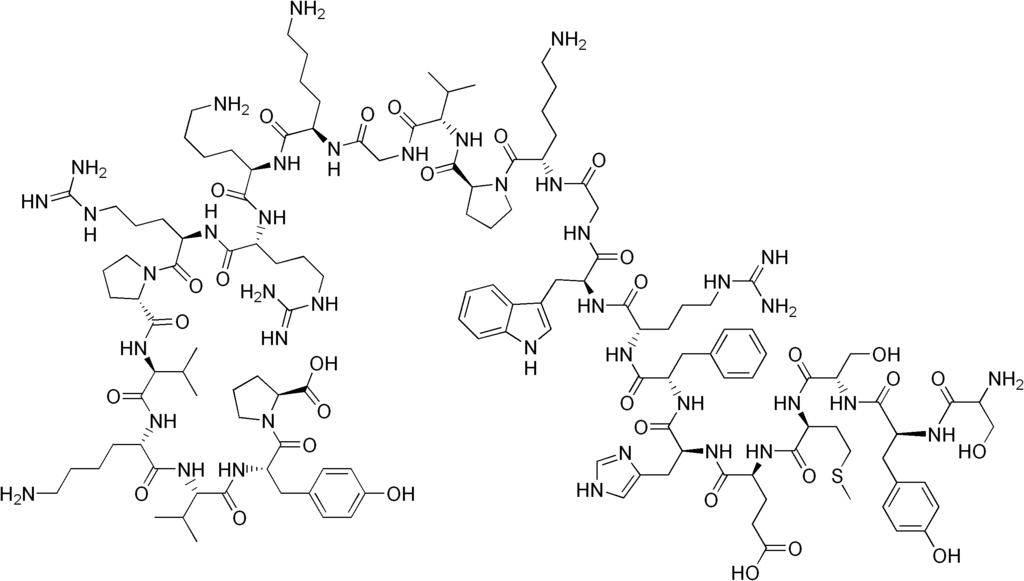Tetracosactide
 | |
| Clinical data | |
|---|---|
| AHFS/Drugs.com | International Drug Names |
| MedlinePlus | a605020 |
| ATC code | |
| Identifiers | |
| CAS Number | |
| PubChem CID | |
| ChemSpider | |
| UNII | |
| KEGG | |
| ChEBI | |
| E number | {{#property:P628}} |
| ECHA InfoCard | {{#property:P2566}}Lua error in Module:EditAtWikidata at line 36: attempt to index field 'wikibase' (a nil value). |
| Chemical and physical data | |
| Formula | C136H210N40O31S |
| Molar mass | 2933.44 g/mol |
| |
| | |
|
WikiDoc Resources for Tetracosactide |
|
Articles |
|---|
|
Most recent articles on Tetracosactide Most cited articles on Tetracosactide |
|
Media |
|
Powerpoint slides on Tetracosactide |
|
Evidence Based Medicine |
|
Clinical Trials |
|
Ongoing Trials on Tetracosactide at Clinical Trials.gov Trial results on Tetracosactide Clinical Trials on Tetracosactide at Google
|
|
Guidelines / Policies / Govt |
|
US National Guidelines Clearinghouse on Tetracosactide NICE Guidance on Tetracosactide
|
|
Books |
|
News |
|
Commentary |
|
Definitions |
|
Patient Resources / Community |
|
Patient resources on Tetracosactide Discussion groups on Tetracosactide Patient Handouts on Tetracosactide Directions to Hospitals Treating Tetracosactide Risk calculators and risk factors for Tetracosactide
|
|
Healthcare Provider Resources |
|
Causes & Risk Factors for Tetracosactide |
|
Continuing Medical Education (CME) |
|
International |
|
|
|
Business |
|
Experimental / Informatics |
Editor-In-Chief: C. Michael Gibson, M.S., M.D. [1]
Overview
Tetracosactide (marketed under the brand name Synacthen) is a synthetic analogue consisting of the first 24 amino acids of the naturally occurring adrenocorticotrophic hormone (ACTH). It is known to be used as a doping agent to increase the secretion of glucocorticoids by adrenal glands.[1]
Pharmacology
In the normal situation, ACTH is released from the pituitary gland at the base of the brain. It acts on the adrenal glands to stimulate the production of steroid hormones (glucocorticoids). If the adrenal glands are healthy, a single injection of tetracosactide results in a rise in blood cortisol (hydrocortisone) concentrations in 30 minutes. If the adrenal glands appear not to be working then tetracosactide injection can be given to check whether the problem is due to diseased or damaged adrenals or due to lack of pituitary ACTH.
Uses
This medication is used for diagnostic purposes only (e.g. in short synacthen test). It is suitable for treatment of adrenal insufficiency of central origin.
As well as its legitimate medical applications, it has been widely reported that Synacthen has also been used as an illegal performance enhancing drug by professional cyclists.[2]
It has been used in the treatment of infantile spasms.[3]
See also
- Cosyntropin, a similar drug
References
- ↑ Chaabo A, de Ceaurriz J, Buisson C, Tabet JC, Lasne F (February 2011). "Simultaneous quantification and qualification of synacthen in plasma". Anal Bioanal Chem. 399 (5): 1835–43. doi:10.1007/s00216-010-4565-z. PMID 21170520.
- ↑ Kimmage P (2007). "tour 87 stage 14". Rough Ride. Yellow Jersey Press. p. 125. ISBN 0-224-08017-2.
- ↑ Lux AL, Edwards SW, Hancock E, Johnson AL, Kennedy CR, Newton RW, O'Callaghan FJ, Verity CM, Osborne JP (2004). "The United Kingdom Infantile Spasms Study comparing vigabatrin with prednisolone or tetracosactide at 14 days: a multicentre, randomised controlled trial". Lancet. 364 (9447): 1773–8. doi:10.1016/S0140-6736(04)17400-X. PMID 15541450.
- Pages with script errors
- CS1 maint: Multiple names: authors list
- Template:drugs.com link with non-standard subpage
- E number from Wikidata
- ECHA InfoCard ID from Wikidata
- Articles with changed InChI identifier
- Chemical articles with unknown parameter in Infobox drug
- Chemical pages without DrugBank identifier
- Drugs with no legal status
- Drugboxes which contain changes to verified fields
- Drug
- Hormonal agents
- Peptides